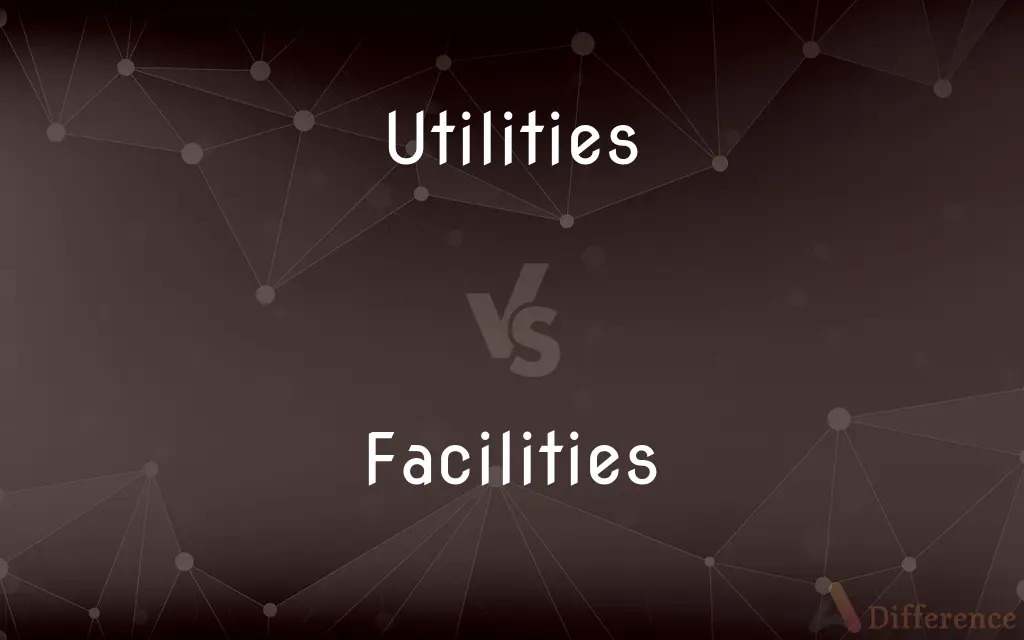Utilities vs. Facilities — What's the Difference?
Edited by Tayyaba Rehman — By Maham Liaqat — Updated on August 16, 2024
Utilities are essential services such as water, electricity, and gas provided to buildings, while facilities refer to buildings, spaces, or services designed for a specific function, like schools or gyms.

Difference Between Utilities and Facilities
Table of Contents
ADVERTISEMENT
Key Differences
Utilities encompass the basic services necessary for a building's operation and its occupants' comfort and functionality. These services include water supply, electricity, gas, sewage, and telecommunications. Utilities are fundamental for residential, commercial, and industrial properties, ensuring a livable and workable environment. They are typically delivered to properties through infrastructure networks and are charged based on usage. Facilities, on the other hand, represent the physical spaces and structures designated for specific activities and purposes. This term can include commercial buildings, educational institutions, recreational areas, and specialized services like healthcare centers.
Utilities are essential services that make a space functional, while facilities are the physical manifestations of spaces designed for particular uses. Utilities are integrated into facilities to make them operational. For example, a school (facility) requires electricity and water (utilities) to function effectively.
The management of utilities involves ensuring the continuous and efficient delivery of essential services, often dealing with external suppliers and regulatory bodies. Facility management, however, encompasses a broader scope, including the maintenance and operation of the buildings themselves, ensuring they meet the specific needs of their users.
Utilities and facilities are interconnected yet distinct concepts. Utilities refer to the indispensable services that support daily living and working environments, while facilities are the spaces designed for specific functions, relying on utilities to become fully operational and serve their intended purpose.
Comparison Chart
Definition
Essential services such as water, electricity, and gas
Physical spaces designed for specific activities
ADVERTISEMENT
Examples
Water supply, electricity, natural gas, sewage
Schools, hospitals, office buildings, gyms
Purpose
To provide essential services for living and working
To house specific activities or functions
Management
Involves the supply and regulation of services
Includes maintenance, operation, and administration
Dependency
Facilities depend on utilities to be functional
Utilize utilities to ensure operational efficiency
Compare with Definitions
Utilities
Essential service systems in a building.
The new apartment complex offers all major utilities, including high-speed internet.
Facilities
Buildings or spaces for specific uses.
The community center is one of the best facilities for indoor sports in the area.
Utilities
Critical for modern living.
During the power outage, residents realized how dependent they are on basic utilities.
Facilities
May offer multiple services.
The health facility includes a gym, spa, and rehabilitation services.
Utilities
Include telecommunications services.
To work from home effectively, reliable utilities like internet and phone service are essential.
Facilities
Require regular maintenance.
Facility management is crucial for keeping the school in good condition.
Utilities
Charged based on consumption.
Their monthly utilities bill includes charges for water, electricity, and gas.
Facilities
Designed with a specific purpose in mind.
The new research facility was built specifically for advanced scientific studies.
Utilities
Often regulated by government entities.
The city's utilities commission approved a rate increase for water service.
Facilities
Can be public or private.
Local government plans to upgrade public facilities, including libraries and parks.
Utilities
The quality or condition of being useful; usefulness
"I have always doubted the utility of these conferences on disarmament" (Winston S. Churchill).
Facilities
A building, room, array of equipment, or a number of such things, designed to serve a particular function
Hospitals and other health care facilities.
Utilities
A useful article or device.
Facilities
Something that facilitates an action or process
The region has very poor transportation facilities.
Utilities
A public utility.
Facilities
Synonym of facilityin certain contexts.
Utilities
A commodity or service, such as electricity, water, or public transportation, that is provided by a public utility.
Utilities
Plural of utility
Common Curiosities
Who manages utilities and facilities?
Utilities are often managed by utility companies or municipal entities, while facilities are managed by property owners, businesses, or facility managers.
What's the difference between utilities and facilities?
Utilities are essential services like water and electricity needed for daily operations, whereas facilities are spaces designed for particular activities.
Can the same entity manage both utilities and facilities?
Yes, some organizations, particularly large institutions or companies, may manage both their facilities and the utilities services within those spaces.
How are utilities provided to facilities?
Utilities are delivered through infrastructure networks, such as power lines and water pipes, and are integrated into facilities during construction or through later modifications.
Are utilities included in the cost of using a facility?
It depends on the agreement. In some cases, utilities are included in the rental cost of a facility, while in others, users may pay for utilities separately.
What happens when utilities are disrupted in a facility?
Disruptions can halt operations, affect comfort, and in some cases, require the facility to temporarily close until services are restored.
Can a facility operate without utilities?
Generally, no. Facilities need utilities like water and electricity to be functional and serve their intended purpose.
How do utilities impact the design of a facility?
The need for utilities influences the design and layout of facilities, ensuring that essential services are accessible and meet the operational requirements of the space.
How do advancements in utilities technology affect facilities?
Innovations in utilities, such as renewable energy or smart grids, can lead to more efficient and sustainable facility operations.
Are there facilities that provide utilities?
Yes, facilities like power plants, water treatment centers, and telecommunications hubs are essential in generating and distributing utilities.
Share Your Discovery

Previous Comparison
Polyglot vs. Polymath
Next Comparison
Greenhouse Effect vs. Global WarmingAuthor Spotlight
Written by
Maham LiaqatEdited by
Tayyaba RehmanTayyaba Rehman is a distinguished writer, currently serving as a primary contributor to askdifference.com. As a researcher in semantics and etymology, Tayyaba's passion for the complexity of languages and their distinctions has found a perfect home on the platform. Tayyaba delves into the intricacies of language, distinguishing between commonly confused words and phrases, thereby providing clarity for readers worldwide.













































